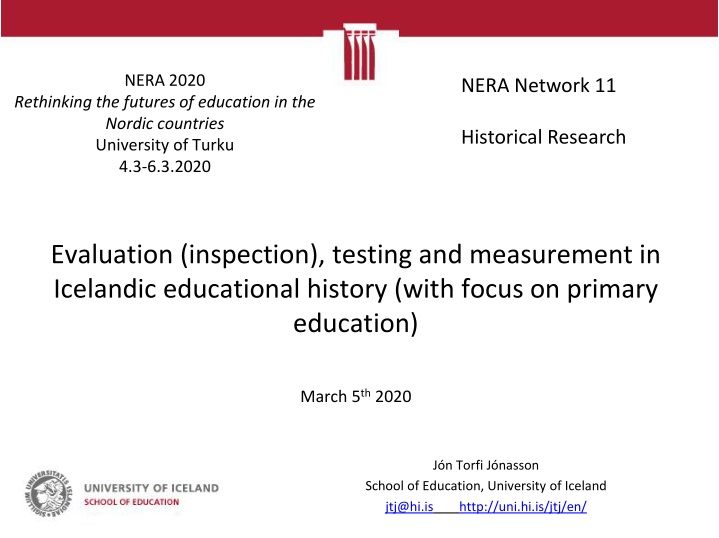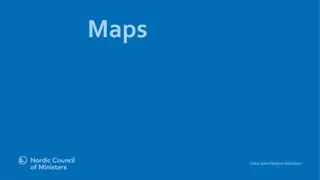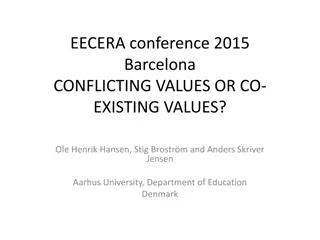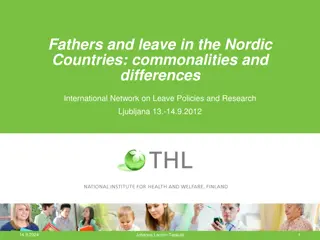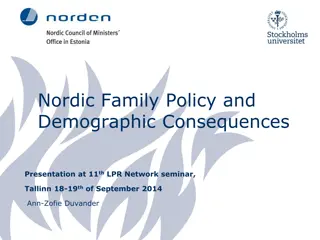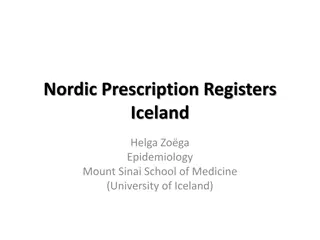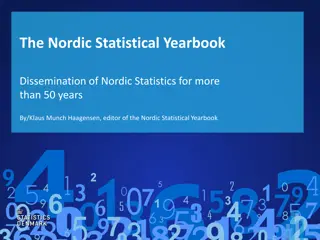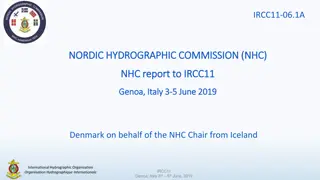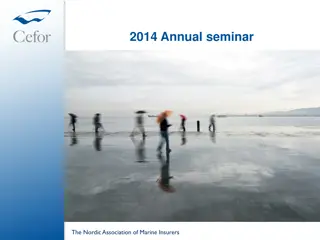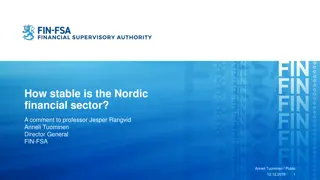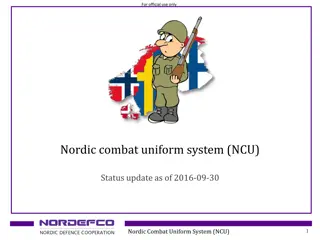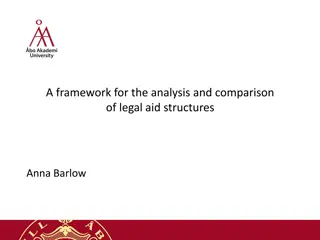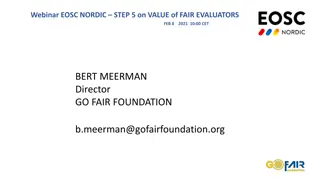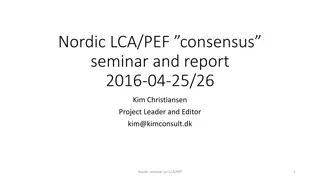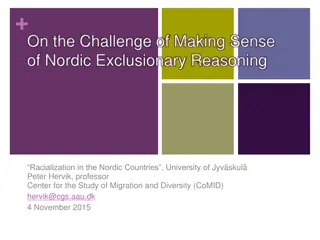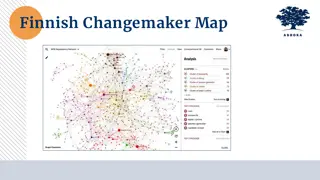Rethinking Education Data Emphasis: Reflections from Nordic Context
Recent trends in education highlight the significance of data usage and evaluation strategies. This study explores the historical roots and modern implications of data collection in Icelandic education, focusing on evaluation practices at system and student levels. Through an analysis of past ordinances and laws related to education, the research sheds light on the evolution of evaluation methodologies in the Nordic context.
Uploaded on Feb 25, 2025 | 0 Views
Download Presentation

Please find below an Image/Link to download the presentation.
The content on the website is provided AS IS for your information and personal use only. It may not be sold, licensed, or shared on other websites without obtaining consent from the author.If you encounter any issues during the download, it is possible that the publisher has removed the file from their server.
You are allowed to download the files provided on this website for personal or commercial use, subject to the condition that they are used lawfully. All files are the property of their respective owners.
The content on the website is provided AS IS for your information and personal use only. It may not be sold, licensed, or shared on other websites without obtaining consent from the author.
E N D
Presentation Transcript
NERA 2020 NERA Network 11 Rethinking the futures of education in the Nordic countries University of Turku 4.3-6.3.2020 Historical Research Evaluation (inspection), testing and measurement in Icelandic educational history (with focus on primary education) March 5th2020 J n Torfi J nasson School of Education, University of Iceland jtj@hi.is http://uni.hi.is/jtj/en/
Background and rationale A. The recent emphasis on data, at all levels. System, school, student levels. We seem to have recently discovered how good it is to have data or the relevant information. B. The emphasis on evaluation for governance, teaching and learning a part of the trend towards decentralisation and modern (new public) management. C. The recent emphasis on data for feedback, guidance, formation rather than tracking and summative evaluation. D. My recent paper on the emphasis on data, and its non-directional value (where I substantiate the above claims). Currently we have the acknowledgment or belief that much of this fascination with relevant information is relatively new and modern and thus we are essentially moving into new territory. also the conviction that the major influence on evaluation and measurement is from outside, e.g. driven by recent neo-liberal forces augmented in particular by OECD. Not wanting to disturb any such conceptions, it may still be important to explore if there are some earlier traces or kindred examples of these modern ideas. I will frame this within the Icelandic context which in many cases is explicitly Nordic, or was, in the early days. J n Torfi J nasson NERA Turku 2020 - Evaluation, testing and measurement 2
Rationale for collection of data in education, both from the historical and modern perspectives. A. System level. For evaluative purposes (perhaps three main periods in Iceland). Student testing is involved, partly for assessing system performance, partly for equity reasons and partly for entry level purposes (minimum standards). But the focus on testing is, in this category, is on the operating system rather than the students. We find that inspections and comparisons are done in order to evaluate or advance the system. B. Student level. The focus is on the student. For student competence (summative), control of students (summative), student tracking (summative), student equity (summative), or student learning (formative). Thus collection of data is based on student testing or related assessment. J n Torfi J nasson NERA Turku 2020 - Evaluation, testing and measurement 3
For evaluative purposes I. 17th-19th century Within the system The main ordinances (and later laws) related to education during previous centuries can be characterized as an inspection system. For quite a long time it was the protestant and chiefly the Pietist, emphasis on learning to read, which was the responsibility of the parents (the home) but essentially the responsibility of the priests to ensure that this was in order. Ordinance on confirmation 1635, 1736, 1744 (+1746), 1760, 1790 An example: a royal ordinance sent to the bishops 1790 The responsibility of parents to teach children (mainly to read) but also for confirmation. It was clearly the responsibility of the clergy to see that this was done and they were fined, by the bishop, for deficient performance. Thus essentially a hierarchical inspection system was operating. A law on teaching children writing and arithmetic 1880; essentially using the same control system. Thus home schooling with an inspection system, involving the clergy, was operative for some centuries. The involvement of priests in actual teaching varied. This system was operative for quite some years after schools became more common in the late 19th century (and prior to the first law on state education in 1907). For some decades there were essentially two inspection systems operating as both examinations and inspection by the clergy were in force. J n Torfi J nasson NERA Turku 2020 - Evaluation, testing and measurement 4
For evaluative purposes II. 1920s-1930s (1929-1937) Within the system During the 1920s and 1930s there was a heated and extended discussion about data, measurement and examinations. This was mainly driven by the teachers themselves, partly under foreign influence (e.g. from the US but also other countries). The arguments were largely based on demands for equity (between districts and types of schools) and educational quality (all children deserved to receive good education). Even though teacher based tests were used considerably in order to control or discipline the students, they were not necessarily used for tracking (but that came later). In the late 1920s there were two parallel system developments: I. A system of national tests was developed in a number of subjects. (They had to be national and written tests not oral, for the sake of equity and transparency). II. A system of inspectors was set up at the district level and these were now supposed to replace the clergy to test the students and inspect the state of schools and related facilities. It is possible that at no time in Icelandic educational history has there been operated such an extensive system of inspection of education as at this time (around 1930). This system lasted only for a few years even though many traces of it lived much loner. J n Torfi J nasson NERA Turku 2020 - Evaluation, testing and measurement 5
For evaluative purposes II. 1920s-1930s (1929-1937) Within the system The following tests were administered in the period 1929-1937 (but only in reading and arithmetic after that). During 1931-1932 a special inspection effort was made throughout the country and thus these tests were not administered during that time. 1929 1930 1931 1932 1933 1934 1935 1936 1937 Year (spring) 7-14 7-14 7-14 7-14 7-14 X Vocal reading 10-14 10-14 10-14 Silent reading 10-14 F Spelling 10-14 10-14 Writing 10-14 10-14 10-14 10-14 10-14 10-14 Arithmetic 12-14 F Grammar F Essay writing F Geography F Natural science F History J n Torfi J nasson NERA Turku 2020 - Evaluation, testing and measurement 7-14, 12-14 and 10-14 refers to the age groups tested. F-refers to final examination in these subjects, normally when the children were 14 years old. (JTJ, based on reports written by Bjarni M. J nsson). 6
For evaluative purposes III. (1990) - 2008 present Within the system Internal evaluation (more or less) 1990-2008 The compulsory schools were moved under the control of the state in 1974 but back again in 1995 and then with the idea of a good evaluation system being developed. The idea of school evaluation gradually develops, already from about 1990, through to 2008 with different (political) emphasis and different argumentation. The issues that come up relate to who should be responsible (e.g. the professional in the field, or the municipalities for compulsory education - or the ministry). (See Bj rk lafsd ttir. (2016). Tilur og r un ytra mats slandi fr 1991 til 2016, http://netla.hi.is/greinar/2016/ryn/14_ryn_arsrit_2016.pdf) An evaluation and inspection unit was set up within the ministry in 1996. Crudely, the period from 1990-2008 was characterised by gradually more emphasis on internal evaluation (and evaluation of this process). There was some external evaluation at this stage. Internal and external evaluation 2008-present In a series of laws passed in 2008 the emphasis has been on both internal and external evaluation. These processes were both emphasised and specified but only partly financed. 2013 A special evaluation unit was set up at the Icelandic Educational Testing Institute 2015 A Directorate of Education was instituted by law. Among its tasks is to monitor and evaluate school progress. J n Torfi J nasson NERA Turku 2020 - Evaluation, testing and measurement 7
Inspection outside the system for evaluative purposes external and internal agents these were not a part of the system 1307 Visitatores inspectors to check on the knowledge of the clergy 1741-1745 The Pietists, Harboe and J n orkelsson (perhaps the most extensive and influential? external review of Icelandic education) 1903-1905 The Status of Icelandic schools Gu mundur Finnbogason 1921 Formal external evaluation of Mi b jarsk linn Reykjav k 1930-1931 Examination of all schools and school children in Iceland 1986 OECD evaluation of Icelandic schools (no PIRLS or PISA yet) [2008 OECD Review of tertiary education] 2017 EDUCATION FOR ALL IN ICELAND. External Audit of the Icelandic System for Inclusive Education, by the European Agency J n Torfi J nasson NERA Turku 2020 - Evaluation, testing and measurement 8
Comparison for evaluate purposes Inter system P ll Briem, a lawyer and a senior administrator in Iceland; very influential in the formation of Icelandic education. In a series of articles in 1900 he made a number of detailed comparisons with other countries in the field of education. Here he suggests that the contribution per capita in Iceland is similar to Portugal, roughly 0,50 kr. just above Russia. There are important historical examples of comparative data being used in order to strengthen a policy argument for education in Iceland. J n Sigur sson in 1842. P ll Briem in 1900 (all kinds of comparisons) Calls for comparison in educational performance: Steingr mur Arason in 1919 (within and between, systems and performance) Bjarni M. J nsson in 1937 (international data) IEA reading study, 1991 low results for 9 years old high for 14 years old (highest of all in expository text). Then TIMSS, PIRLS in the 1990s and later PISA (from 2000). J n Torfi J nasson NERA Turku 2020 - Evaluation, testing and measurement 9
Summary: Collecting data For evaluative purposes 4-5 approaches to evaluation 1. Government delegates responsibility to somebody within the system here, the clergy with the bishop finally responsible with a infrastructure of oversight. (Ordinances 1635, 1736, 1744,1746, 1760, 1790 and law 1880). 2. Government asks for an independent external evaluation, which is thus outside the system (Visitatores 1307, Harboe 1741+, Finnbogason 1903+, OECD 1986, 2008, European Agency 2017). 3. Compare and adapt the system to other systems, inter system comparison a system seen in the light of other systems. There exist several discursive examples, but the most influential was perhaps the comparison leading to the series of new laws in 1946, various parts of the laws for compulsory education in 1974 and 2008 and the proposals in the White paper, 2014. This has also been implicit in the adoption of the PIRLS, TIMSS, and PISA tests and their use to motivate change. 4. Government now with its own educational system, constructs a set of evaluation instruments. A. Constructing a system of national tests which allows evaluation and inspection. The tests used during the 1930s were of that sort and also the national examinations that were developed from 1974 and have been used in various guises, either as compulsory or voluntary tests, now intended more for formative than summative purposes. B. Constructing an inspection system, mainly with internal, but also with external evaluation. The inspector system established in the 1930s was a hybrid of these and so was the system that gradually developed from 1995, with a more clear-cut binary system from 2008. J n Torfi J nasson NERA Turku 2020 - Evaluation, testing and measurement 10
Collecting data for For summative purposes gradually used for tracking The main ordinances and laws related to education during previous centuries can be characterized as having a summative reference. Basically they only set a minimum standard (i.e. passing a certain minimum criterion). As the school system started to develop, basically every student obtained a mark in every class in every subject. As the teachers attempted to move away, (some) parents objected fiercely, but the teachers gradually won (this is in the early 1900s). During the 1920s the teachers wanted national written tests, basically for equity purposes; expecting to use the tests to develop a sturdier schools system. They succeeded in the end. As the school system started to develop the tests acquired a tracking or sorting role. This was essentially dismantled by the law enacted in 1974. From then on we had a somewhat elaborate examination system, with ostensibly a formative role and no tracking role. It is not clear that it actually has much formative use, but has marginal tracking role. The table shows the % of students taking the exams, some of which could be opted for or were voluntary, but after 2000 all of them were. Standarised tests 1977-2006+ 1977 1978 1979 1980 1981 1982 1983 1984 1985 1986 1987 1988 1989 1990 1991 1992 1993 1994 1995 1996 1997 1998 1999 2000 2001 2002 2003 2004 2005 2006 2007 2008 2009 2010 2011 2012 2013 2014 2015 2016 2017 2018 2019 10th class icelandic 91 91 91 92 92 62 29 46 45 92 91 58 33 45 45 91 91 54 37 44 46 92 92 92 91 91 91 92 90 92 93 92 91 90 90 90 88 91 91 91 90 90 90 89 88 94 94 95 92 92 91 92 90 95 95 95 95 95 96 95 93 96 98 96 99 95 99 95 96 96 97 97 96 96 94 97 96 97 97 96 Mathematics English Danish+ Natural history 40 Social studies 50 97 97 96 96 96 94 95 96 96 96 96 96 97 96 96 95 94 96 96 96 96 97 95 96 95 95 92 87 85 85 78 77 75 69 69 65 58 55 53 63 58 49 43 40 7th class icelandic Mathematics icelandic Mathematics 96 97 97 96 97 96 96 93 94 95 94 95 93 94 97 97 98 97 97 96 97 94 94 95 4th class 97 96 96 96 96 94 95 93 93 94 J n Torfi J nasson NERA Turku 2020 - Evaluation, testing and measurement 97 97 97 96 96 96 95 94 93 94 11 Number show the % of students taking the examination From JTJ, 2008; +
Collecting data For formative purposes 1888 compulsory examination should be a requisite for confirmation. An opponent argued that this was unfair; a much earlier examination would allow some remedial action to be taken in favour of the child; essentially a formative argument. Discussion in parliament. In a proposed bill it was proposed that passing the 1974 in 1974. It is very clear that the discussion about testing in the document contained the rhetoric of formative use of tests. It is however doubtful that this had much influence on the way tests were used for the next forty years. Discussion in background document to the proposed law that was enacted Previously used tests in 4th and 7th (prior to 1974) were enacted again, with 1996 explicit formative role. 2000?? Recent discussion among professionals indicates an emphasis on formative rather than summative use of evaluation. J n Torfi J nasson NERA Turku 2020 - Evaluation, testing and measurement 12
An attempt at an overview A school system starts to form in Iceland during the latest part of the 19th century as indicated in the bottom four lines in the figure. Prior to the early 1900s there was no education system . The box is meant to indicate a period in which the school system is forming, but the first law on compulsory education was set in 1907. Many of the changes that take place fade in but particularly they fade out before they may be revived. Many different but related things happen in the 1930s which is probably the most active period, when we take the system perspective. The different colours are only meant to distinguish between the different lines. 1700 1800 1900 2000 An overview Evaluation regimes 1 2 3 4 5 6 7 8 9 10 1 2 3 4 5 6 7 8 9 10 1 2 3 4 5 6 7 8 9 10 1 2 Government delegates within the system Government asks for independent evaluation International comparisons Government insitutes national tests Government establishes an inspection system Student based testing Formative efforts or discourse J n Torfi J nasson NERA Turku 2020 - Evaluation, testing and measurement 13
Some conclusions Inspection and evaluation has been a part of the Icelandic educational edifice for a long time. There is little new in the modus operandi of this process, but the rationality underpinning the different mechanisms has changed. Very early on, the authorities assumed responsibility for ensuring that the main actors did their job properly, i.e. teaching children to read and understand the basic religious tenets. There seems to be a gradual move in this direction again (with the current content). It is difficult to assess the direct or overarching effects of the various evaluations that have been undertaken. There is considerable anecdotal evidence attesting to their incidental effects, but it is difficult to ascertain to what extent these changes were substantial or would have taken place anyway. It is also difficult to assess or compare the influence of these different strands of data or projects or efforts. The testing mechanisms (the examinations) have certainly been more visible, than the various and ambitious evaluation efforts. The former, the tests, have possibly (probably) rather hindered change than motivated it. This is of course difficult to assess, but it is not clear how that type of data has been a tool for change. The massive data sets available (mainly tests results) have not, in any obvious ways, led to changes or developments. (Here I have in mind the massive data sets from the 1930s, the voluminous data from the national tests and then also from the various international studies in which we have participated for the last three decades.) In general terms the tracking mechanisms in Icelandic schools, based on examination results, have been gradually weakened or even dismantled. This has probably more to do with the acknowledgment of the pernicious influences of data (examinations) than the explicit use of data to engender change. Perhaps one reason for less harnessing of data than one might expect is that data has less directional value than is often assumed. Except within a tracking regime, data, and notably examination results, carry with them preciously little directional value (except to challenge one to work harder next time round). J n Torfi J nasson NERA Turku 2020 - Evaluation, testing and measurement 14
Thanks J n Torfi J nasson NERA Turku 2020 - Evaluation, testing and measurement 15
